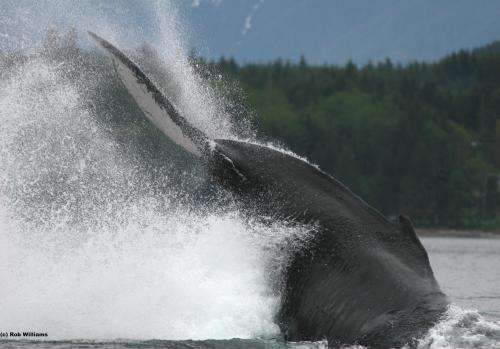Researchers estimated abundance of Pacific humpback whales (Megaptera novaeangliae) using photo-identification surveillance of identifiable adults. Credit: Rob Williams
Humpback whale populations are on the rise in the coastal fjords of British Columbia, doubling in size from 2004 to 2011, according to results published September 18 in the open access journal PLOS ONE by Erin Ashe from the Sea Mammal Research Unit at the University of St. Andrews and colleagues from other institutions.
Researchers estimated abundance of Pacific humpback whales (Megaptera novaeangliae) using photo-identification surveillance of identifiable adults. They found that the number of humpback whales in the region increased each year, and doubled from 2004 to 2011, resulting in a total of 137 whales in 2011. The survey was conducted year-round, but abundance was estimated only during the summer months of July to September, when the migrating whale population is largest.
The survey focused on summer feeding regions in the coastal fjords that serve as a pit stop for whales to refuel between migrations. Migrating whales can travel as far as Hawaii or Japan and go several months without feeding. Whatever the whales are doing seems to be working. The authors estimated that survivorship, the average probability of an adult whale surviving from one year to the next is among the highest reported anywhere for this species. During this critical refueling stage in these waters, the whales are more vulnerable to environmental stressors, such as those potentially created by increasing tourism and industrial development in the region.
More information: Ashe E, Wray J, Picard CR, Williams R (2013) Abundance and Survival of Pacific Humpback Whales in a Proposed Critical Habitat Area. PLoS ONE 8(9): e75228. DOI: 10.1371/journal.pone.0075228
Journal information: PLoS ONE
Provided by Public Library of Science






















